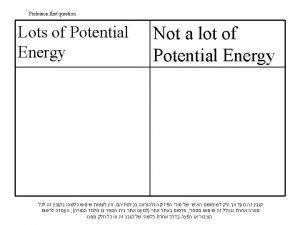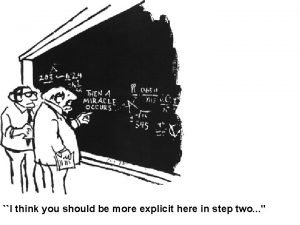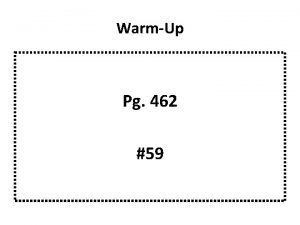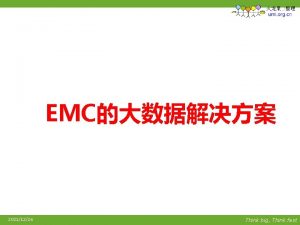Warmup Who do you think has more power
















- Slides: 16

Warm-up Who do you think has more power in the marketplace, the buyer or the seller? Why?

Chap. 6 Sect. 2 Combining Supply and Demand Goals: 5. Explain how supply and demand create balance in the market. 6. Explain how the market reacts to a fall in supply by moving to a new equilibrium. 7. Explain how elasticity of demand creates a wider range of prices possible in reaction to shifts in supply. 8. Explain how the market reacts to shifts in demand by moving to a new equilibrium.

Supply and Demand The Market System makes certain that: - buyers can find the products they want -sellers are able to make a profit -sellers respond to changing wants/needs of buyers Supply and Demand work together bringing competing interests of buyers and sellers to a positive outcome

Balancing the Market Equilibrium – When the market’s qty supplied and qty demanded are equal to each other and prices are relatively stable. At equilibrium the market is balanced. Equilibrium Price. The price of a good which clears the market of all goods without leaving a shortage or a surplus. At that price - buyers will buy exactly the qty that sellers are willing to supply.

Putting Supply and Demand Together!!! (I know you’ve been waiting your whole life for this moment!)

Supply and Demand are put together to determine equilibrium price and equilibrium quantity Supply Schedule Demand Schedule P Qty $3 50 $3 350 $2. 50 100 $2. 50 300 $2 150 $2 250 $1. 50 200 $1 250 $1 150 $. 50 300 $. 50 100 What if the price increases to $3? Equilibrium Price = $1. 50 Equilibrium Qty = 200

Supply and Demand are no longer equal. Qty Supplied > Qty Demanded = Surplus Supply Schedule Demand Schedule P Qty $3 350 100 $2. 50 300 $2 150 $2 250 $1. 50 200 $1 250 $1 150 $. 50 300 $. 50 100 P Qty $3 50 $2. 50 New Price = $3 Surplus = 300 (QS-QD) = Surplus

Disequilibrium cont. Surplus– occurs when qty supplied exceeds qty demanded. (AKA excess supply) Higher prices encourage sellers to provide more, but keeps buyers from buying – so there a lot of left-overs. What if the price When there is a surplus, the sellers will lower prices and decreasesmake to less, $1? gradually decreasing supply while increasing demand equilibrium will be reached.

Supply and Demand again not equal. Qty Demanded > Qty Supplied = Shortage Supply Schedule Demand Schedule P Qty $3 50 $3 350 $2. 50 100 $2. 50 300 $2 150 $2 250 $1. 50 200 $1 150 $. 50 100 $1. 50 200 $1 250 $. 50 300 New Price = $1 Shortage = 100 (QD-QS = Shortage

Disequilibrium -any point when qty supplied is not equal to qty demanded. Shortage– occurs when qty demanded is more than qty supplied. (AKA excess demand) Lower prices encourages buyers to buy, but discourages sellers to provide products When sellers see the # of people willing to buy, they will gradually raise their prices and supply more as prices go up- less people will be willing to pay and eventually equilibrium is reached

Markets and Equilibrium Market Forces will always push an unbalanced market towards equilibrium. Sellers do not want to waste resources by throwing out surplus goods. Sellers will also see excess demand as an opportunity to increase profits by raising prices. Sellers will change their prices and qty supplied in response to the buyers level of demand.

How to Analyze Shifting Supply and Demand Curves Assume shifts in supply or demand change equilibrium P and Q instantaneously

Easy as 1, 2, 3 Before the change: Draw supply and demand Label original equilibrium price and quantity The change: Did it affect supply or demand first? (The answer is in the story) What caused the shift? Draw increase or decrease After change: Label new equilibrium? What happens to Price? (increase or decrease) What happens to Quantity? (increase or decrease) Let’s Practice!

S&D Analysis Practice 1. Before Change (Draw equilibrium) 2. The Change (S or D, Identify Shifter) 3. After Change (Price and Quantity After) Analyze Hamburgers 1. Price of sushi (a substitute) increases 2. New grilling technology cuts production time in half 3. Price of burgers falls from $3 to $1. 4. Price for ground beef triples 5. Human fingers found in multiple burger restaurants.

Double Shifts • Suppose the demand for sports cars fell at the same time as production technology improved. • Use S&D Analysis to show what will happen to PRICE and QUANTITY. • If TWO curves shift at the same time, EITHER price or quantity will be indeterminate

Effects of Demand Elasticity When a supply shift happens and the good has inelastic demand, the change in qty demanded will be very small relative to the original data. When a supply shift happens and the good has elastic demand, the change in qty demanded will be much larger relative to the original data.
 Lirik lagu more more more we praise you
Lirik lagu more more more we praise you More more more i want more more more more we praise you
More more more i want more more more more we praise you Mukesh ambani signature
Mukesh ambani signature You have more potential than you think
You have more potential than you think 5 apples in a basket riddle
5 apples in a basket riddle The more you study the more you learn
The more you study the more you learn If you think you can you can poem
If you think you can you can poem I think you should be more explicit here in step two
I think you should be more explicit here in step two Warmup ratio
Warmup ratio Warmup 65
Warmup 65 Gmass warmup
Gmass warmup Stratified warmup
Stratified warmup Pyramid warmup
Pyramid warmup Warm rhyming words
Warm rhyming words Multiplying exponents
Multiplying exponents Java warmup
Java warmup Define:warmup
Define:warmup



























